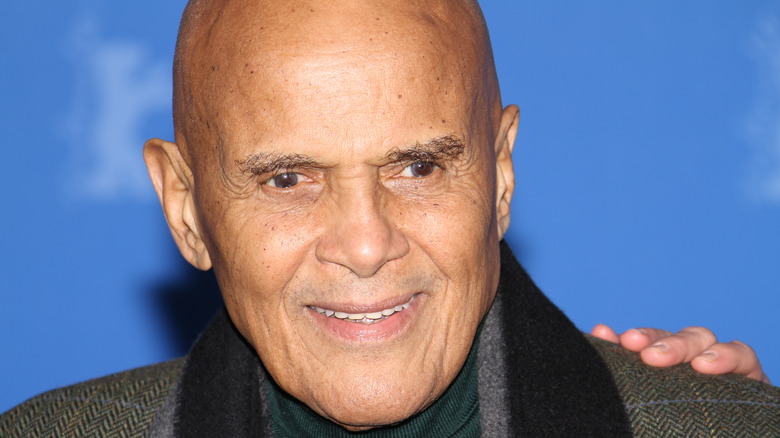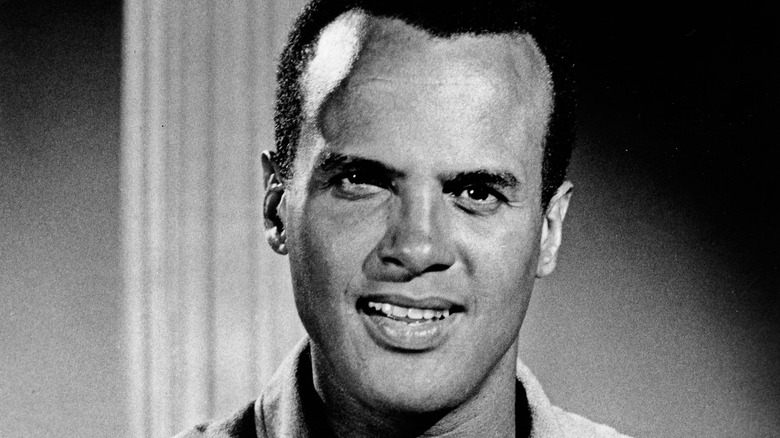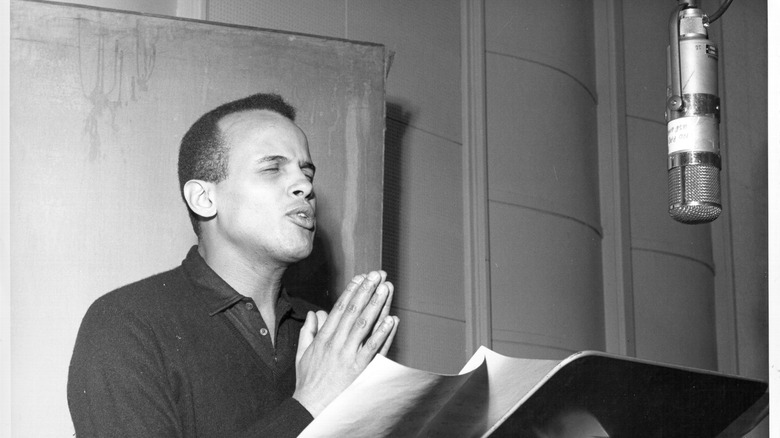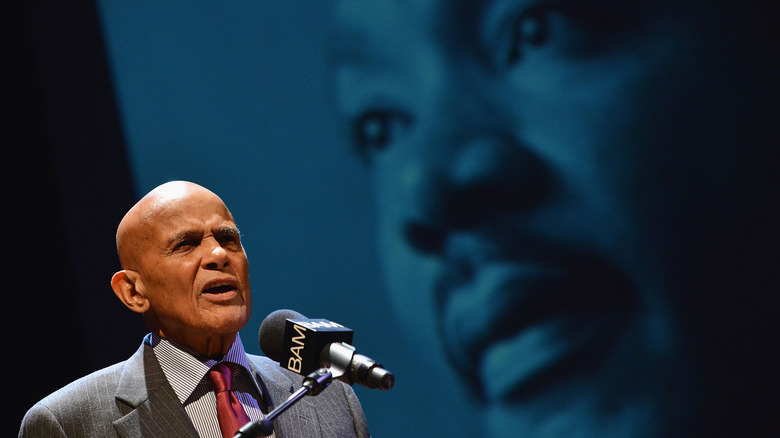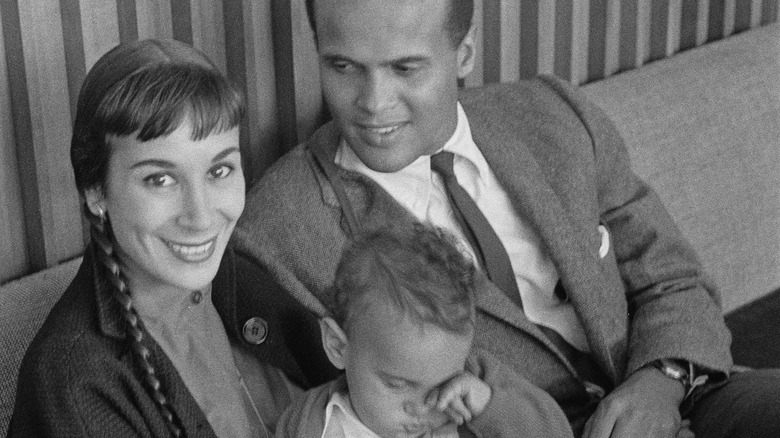The Heartbreaking Death Of Harry Belafonte
Harry Belafonte — actor, singer, and activist — died on April 25, 2023, at age 96.
Though the main thing younger generations typically know about Harry Belafonte is his hit, "The Banana Boat Song" — also known as the "Day-O" song — Belafonte's life was much more than just his hit tunes. The songwriter, singer, and actor popularized Caribbean music in the U.S. and became a film and Broadway star in the 1950s, with his performance in "John Murray Anderson's Almanac" earning him a Tony Award in 1953, via Biography. According to The New Yorker, he was the first artist of any color to have an album go platinum. He was also the first Black idol in the history of U.S. film who was admired and adored for his handsome features and suave personality.
Much of Belafonte's career was marred by the indignities he and Black Americans suffered under Jim Crow. Belafonte recalled in an interview with The New Yorker, for instance, the strange juxtaposition of being booked to play at the prestigious Thunderbird Hotel in Las Vegas, then being denied use of any of the hotel's facilities and forced to sleep in a boarding house just for Black people on the other side of town. Experiences like this led Harry Belafonte to lead a life of activism, and he became a key figure in the civil rights movement.
Harry Belafonte's early years
Harry Belafonte, whose birth name was Harold George Bellanfanti Jr., was born in Harlem, New York to Melvine Love and Harold Bellanfanti, via Britannica, Sing Your Song. Melvine and Harold emigrated from the Caribbean islands of Martinique and Jamaica, and endured severe poverty while raising their son in Harlem, according to The New York Times. Even worse, Harry's father was an alcoholic and abusive toward his mother.
To cope with the abuse and poverty, Melvine found solace in the Catholic Church and sent Harry to parochial school. Harry found Sunday Mass to be "suffocating and interminable," but sat through it because his mother always took him to the Apollo Theater afterward, where he witnessed performances by Cab Calloway, Count Basie, Duke Ellington, Billie Holiday, and Ella Fitzgerald. "I could endure it if I knew that a few short hours later I'd be in the real cathedral of spirituality ... the Apollo," he told The New York Times.
In 1936, Melvine took Harry and his younger brother, Dennis, back to Jamaica, per The New York Times. Harry lived in Jamaica for several years but returned to New York City as a teen. After dropping out of high school because of dyslexia and working odd jobs for a while, The New Yorker states that he enlisted in the U.S. Navy, and returned to New York City once more in 1945. While working as a janitor, Belafonte happened to see a play that changed his life, per The History Makers.
How Harry Belafonte grew to love performing
Harry Belafonte discovered his love for performing when he received free tickets to see a play at the American Negro Theater, via The New York Times. The play, as Belafonte said, "was about returning Black servicemen trying to establish postwar lives in Harlem." Belafonte quickly joined the company and became immersed in theater.
Belafonte also studied drama at Erwin Piscator's Dramatic Workshop, where he landed his first singing role, per Britannica. His singing talent drew the attention of saxophonist Lester Young, who performed at a jazz club called the Royal Roost, per The New York Times. Young offered Belafonte a gig at the club, where he became very successful. "I had a voice the crowd liked, and a look," Belafonte told The Times. "And for white audiences, I carried a reassuring presence, enhanced by my Caribbean diction. Black, but not too Black."
Belafonte's success continued to grow as he developed his signature musical style. As stated by The New York Times, he was inspired by other musicians to dip into folk music, singing "Shenandoah" and other ballads. After performing at other nightclubs, Belafonte landed a record contract and made his first calypso album. For those who don't know, calypso is a style of Caribbean music from the island of Trinidad, according to Master Class. At the same time, Belafonte continued to pursue an acting career and made his film debut in 1953, in the film "Bright Road," via The History Makers.
Harry Belafonte as an activist
As explained by The History Makers, Harry Belafonte formed a close bond with Dr. Martin Luther King Jr. In the early 1950s, just as his career was taking off, Belafonte worked hard to get other artists to actively support the civil rights movement. He also used his talents and celebrity to fund the movement, via The King Institute. In 1956, Belafonte attended the "Salute to Montgomery," a fundraising event in New York, with Coretta Scott King and Duke Ellington.
Belafonte's financial assistance during the civil rights era proved to be essential. In 1963, he hosted a meeting with Dr. King, Fred Shuttlesworth, and other prominent activists to discuss the Birmingham Campaign, per the King Institute. Belafonte not only organized a funding committee for the campaign, but also raised $50,000 while Dr. King was held in a Birmingham jail. When Dr. King was assassinated in 1968, Belafonte was appointed the executor of his estate.
Harry Belafonte remained an activist for the rest of his life. In the 1980s, he raised awareness for the famines, wars, and droughts that rampaged many African nations at the time. He sparked the movement that created USA for Africa, a supergroup of singers who came together to record "We Are the World." The song was performed by over 40 musical artists and led by Michael Jackson and Lionel Richie, via USA for Africa, Rolling Stone. Belafonte was also an anti-apartheid activist and a UNICEF goodwill ambassador, per The History Makers.
Harry Belafonte's personal life
In 1948, Harry Belafonte married actor Marguerite Byrd, whom he met while he was in the Navy and stationed in Virginia, per The New Yorker. The couple had two daughters together, Adrienne and Shari, via Smooth Radio. According to Time, Belafonte convinced Byrd to marry him one day by swinging her over a parapet by the East River. He held her over the water until she said yes to his proposal. Unfortunately, Byrd told The New Yorker that their marriage fell apart over the years, with Belafonte constantly traveling and she pursuing a Ph.D. in psychology. "I just found the show-biz world to be shallow, and false," she also confessed.
In the early 1950s, Belafonte met dancer Julie Robinson on the set of "Carmen Jones," via The New Yorker. Interestingly, Robinson had been previously involved with Marlon Brando, a close friend of Belafonte's. Byrd discovered a stash of love letters from Robinson to her husband in 1954, and it didn't take long for their marriage to fall apart. They divorced in 1957, and Belafonte and Robinson got married later that same year. They had two children, David and Gina, and stayed together for 47 years of marriage. In 2008, Belafonte married photographer Pamela Frank, per Biography. Belafonte is survived by Pamela, his four children, and his five grandchildren — Rachel, Brian, Maria, Sarafina, and Amadeus.
